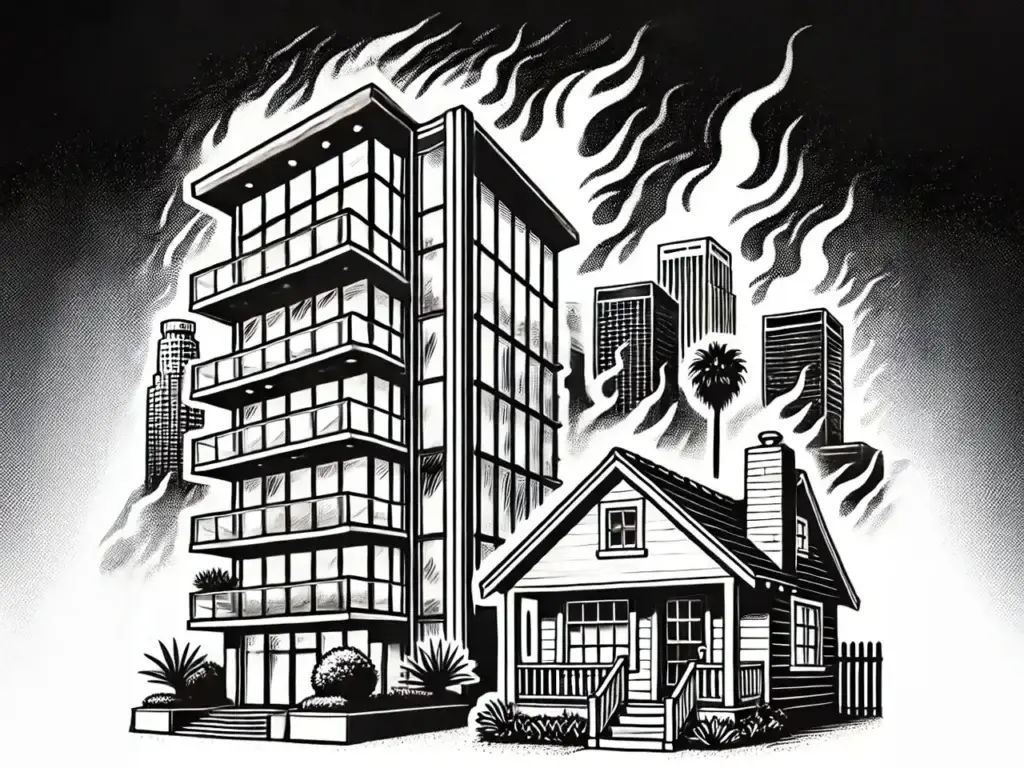NOTE: This article has been significantly updated. Please see new article, LADWP Electric Rates: One That May Save Your HOA Money is Still Secret.
The Los Angeles Department of Water & Power (LADWP) has a little-known electric rate option for condominium common area that might save you money. Maybe a lot.
By LADWP’s own calculations, this rate—the A1A commercial rate—will take 25-30% off our condominium’s common area bills in the summer months.
So why is this rate extraordinarily difficult to find out about?
The Default Residential Rate. Like most condominiums, unit owners in our building get their own electric bills for their unit consumption, and the HOA has a separate meter for common areas. By default, LADWP bills HOA common area electricity at an R1A residential rate which, according to the official rate sheets, applies to “separately metered common areas” of residential condominiums and cooperatives.
However, R1A doesn’t work very well for larger condominiums. Because our condominium was being billed as if it were one home, not a big building serving 26 units, most of our usage ends up in the Tier 3 category. In the summer, Tier 3 is billed at a higher rate to encourage people to conserve on air conditioning.
We had already done a lot to bring down our common area electric bill by replacing all our lighting with LED. The fluorescent tubes in the garage and basement were switched out for LED for free under an LADWP program and we replaced a hodgepodge of other lighting—stairwells, lobby, corridors—ourselves.
Because our condominium was being billed as if it were one home, not a big building serving 26 units, most of our usage ends up in the Tier 3 category.
We saw an immediate reduction of about 18%, with our usual monthly bill now about $2,000.
That was most of the year. Our bills jumped to about $2,600 during the summer due to Tier 3 pricing, even though our usage stays the same.
So I asked LADWP’s customer service department if the tiers could be adjusted to recognize that this bill was for 26 units, not one house.
The Alternative Commercial Rate. Eventually, I ended up with the rates department and received the following message:
Dear Valued Customer,
HOA electric accounts for (Condo’s or Townhomes) have the option to be on R1A- residential or A1A – multi-residential. The electric is assigned residential R1A, however, you may opt to be placed on the A1A multi-rate which is the same as a commercial A1A rate.
This was news. Nothing on the LADWP website or rate sheet had hinted that we were eligible for a different, possibly more favorable rate.
I looked up the A1A commercial rate (I couldn’t find an A1A multi-residential or an A1A multi-rate) and found a calculator on the LADWP website. The results were jaw-dropping.
I wrote back to the rate department to confirm I was looking at the right rate. This time, the reply included their own calculations.
Dear Valued Customer,
A rate comparison of your last 3 bills for [account number] indicate that rate A1A would be most beneficial. Please see comparison below and reply to this email to move forward with processing your rate change:
| R1A Rate | A1A Rate | Difference |
| $2,688 | $1,863 | $825 |
| $2,559 | $1,762 | $796 |
| $2,160 | $1,620 | $540 |
The top two on the list, August and July, were during the summer months when our bill was inflated by Tier 3 pricing. The bottom one was from June.
With monthly bills holding steady at the A1A rates shown above, we would save about 30% in the summer months, with annual savings most likely closer to 20%.
Nothing on the LADWP website or rate sheet had hinted that we were eligible for a different, possibly more favorable rate.
How the A1A Rate Works. The A1A rate factors in “facility demand,” favoring medium-sized buildings with steady demand for power and minimal spikes. Much of our consumption is for lighting that runs 24/7 for safety reasons. We also have an elevator, some various pumps and fans and a small air conditioner for the lobby.
The rate doesn’t save money for every condominium building, but as it turns out, we were a near-perfect candidate. The new rate should save our HOA about $7,000 a year.
After the euphoria wore off, I got angry that I didn’t know about the A1A rate sooner.
Angry that the information was so hard to find.
And angry enough to try to try to figure out how this happened.
2003 CPUC Ruling. Previously, my online searches for electric rates for condominium common areas yielded no hint of this special rate option. Nothing I could find suggested A1A could be applied to residential condominium common areas. Nor had LADWP’s website or rate schedules given me any clues.
Now, adding “A1A” or “commercial rate” to the search terms eventually led me to a California Public Utilities Commission (CPUC) ruling from 2003. (It isn’t easy to find, either.) That complaint, filed against the utility company PG&E by a homeowners’ group known as ECHO, asked the same question I had asked: Why are condominium associations being forced to pay high rates based on a tiered structure intended for single family homes?
CPUC in its ruling agreed that applying the residential rate to condominium common area was unfair:
“This rate structure, which is pegged to average usage of average households, does not reflect common area usage patterns. There is no realistic way for PG&E’s larger common area accounts to avoid extensive over-baseline usage, regardless of how efficient they may become. As a result, mandatory application of the current residential rate design to PG&E’s common area accounts does not meet the equity goals underlying its adoption.”
CPUC ruled that common area HOA customers should be allowed to switch to commercial rates. Under the 2003 ruling, utilities under their jurisdiction were required to send a letter to their customers with historical bill analysis, informing them that the commercial rate was available and might be more favorable.
This option is still open to customers of all privately-owned utilities in California. However, because LADWP is a municipal utility, the CPUC ruling did not apply. So what happened in Los Angeles?
LADWP. I contacted LADWP’s online portal for media requests, stated that I was writing for this website, and asked the following questions:
- Please tell me about the LADWP policy to allow condominiums to choose A1A for common area. How was it adopted? When? How were existing condominium customers notified?
- Is there any place on the LADWP website or other publicly available information that informs condominiums of this option?
- Is the online calculator accurate and using up-to-date rates?
LADWP acknowledged the request but said they needed more time. I gave two reminders and extensions, a total of a week and a half. LADWP acknowledged the correspondence but never sent a substantive response.
Lacking the official viewpoint, here’s what I think might have happened.
Maybe soon after the CPUC decision LADWP made a similar policy change. Maybe they sent out letters to HOA accounts sometime around 2003 or put fliers in the bills or both. Maybe some associations read the letters or fliers and made the change.
But 20 years is forever in the life of a condominium association. Boards change. Managers change.
If someone in the HOA didn’t read the letter 20 years ago and adopt the rate then, it was forgotten. Buried with no directions how to find it again. The change in policy never made it into LADWP’s official rate schedules or onto websites.
Whether the lack of information is deliberate or an oversight, the result is the same. The right of condominiums to choose a more favorable commercial rate is all but impossible to find online.
An Online Clue. Maybe. Was it a forgetful bureaucracy or a deliberate attempt to bury the information? I don’t know.
But I did discover something else—a bit of internet detritus—that seems to support the idea that LADWP intentionally obscures the availability of the A1A rate for condominiums.
What I found appears to be a beta version of the LADWP rate calculator. Rather than being on the LADWP site, this version was on a web page for 3DI Systems, a company that works for LADWP and other local governmental agencies to develop various on-line tools. [Update: the site has since disappeared from on-line.]
This calculator differs from the current LADWP calculator in only two ways: the date range expired in March, and there are little “i” information buttons for each of the various commercial rates (A1A, A1B, A2B and A3A).
Clicking on the information button for A1A reveals this: “The A1A rate is for small commercial and multi-family customers with facility demands under 30 kW.”
When LADWP migrated the rate calculator to its own website, the information buttons disappeared. It’s the only change from the apparent beta version.
[Update: After the publication of this post, LADWP restored the information button on its on-line calculator. Since then, the calculator has been removed in its entirety]
What Needs to Happen. Here’s what LADWP and other utilities need to do.
- The A1A rate description should be amended to include its availability for condominium common areas. [Update: As noted above, the information button has been restored to indicate its availability for multi-family.]
- The utility’s website should clearly state that condominium associations can choose a commercial rate for common area, rather than the residential rate to which they are automatically assigned, and that this change may save them money.
- The utility should instruct condominiums how to determine if a commercial rate will be advantageous, and if so, how to request a rate change.
- The utility should, on a regular basis, notify condominium association customers that this rate is available and may be beneficial to them. Or, if it’s possible, LADWP should just put condominiums in the category that is best for the customer.
Condos Lose, LADWP Wins. Whether the lack of information is deliberate or an oversight, the result is the same. The right of condominiums to choose a more favorable commercial rate is all but impossible to find online. And LADWP has profited from this obscurity.
In 20 years, we probably overpaid LADWP well over $100,000. Enough to reroof our building.
Our HOA has had three different managers during the last 20 years. If managers aren’t aware of this rate, how could board members be expected to know?
Now you know.
Pass it on.—Doris Goldstein
Update 11/8/23: We got our first monthly electric bill under the new rate. It was $1,750, right in line with what LADWP had predicted, and we got a credit of $1,441 for the months that had passed between the approval of the new rate and its actual implementation. I recalculated our annual savings in this blog post downward a bit based on our last year’s actual bills.
Update 7/2/25: The calculator has disappeared from the LADWP website entirely. Condowonk is in the process of updating this article.
Update 9/3/25: Please see follow-ups and significant updates here.








